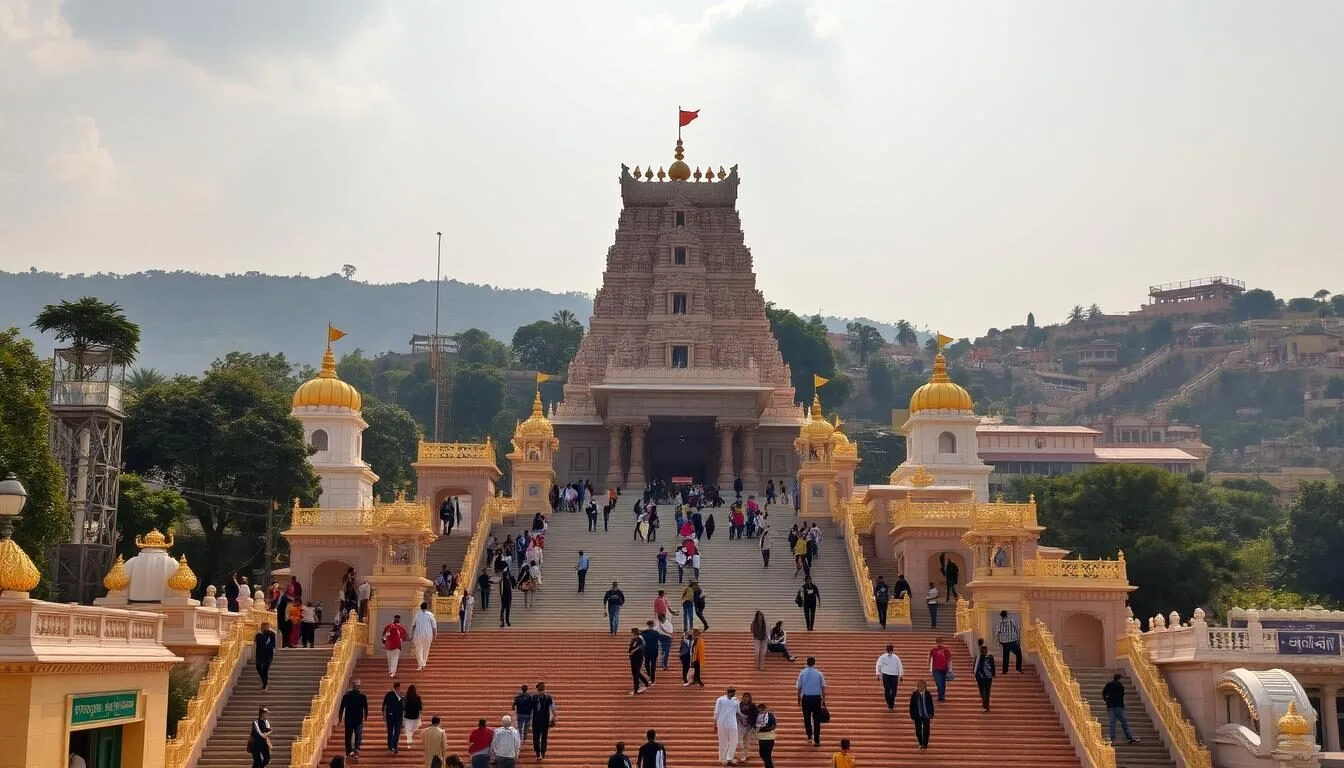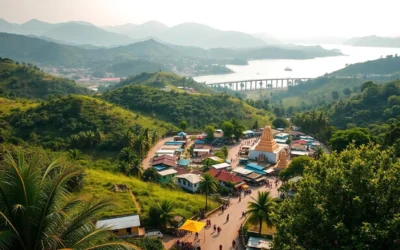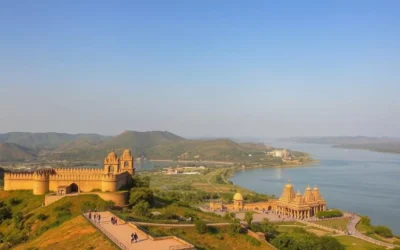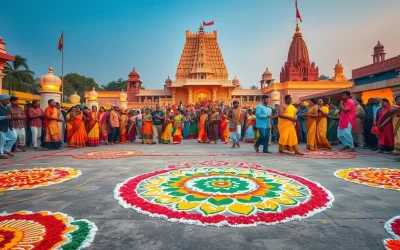✓ Accommodations✓ Flights✓ Rental Cars
Did you know that the Sri Venkateswara Temple in Tirupati attracts millions of devotees every year, making it one of the most visited temples in the world?
This sacred destination in Andhra Pradesh is not just about spirituality; it’s also a place where you can experience the rich cultural heritage of southern India.
As you plan your travel to this incredible destination, you’ll discover a perfect blend of attractions that cater to both pilgrims and tourists alike.
From the revered temple to the breathtaking natural surroundings, Tirupati offers an unforgettable experience that will leave you enchanted.
The Spiritual Heart of Andhra Pradesh
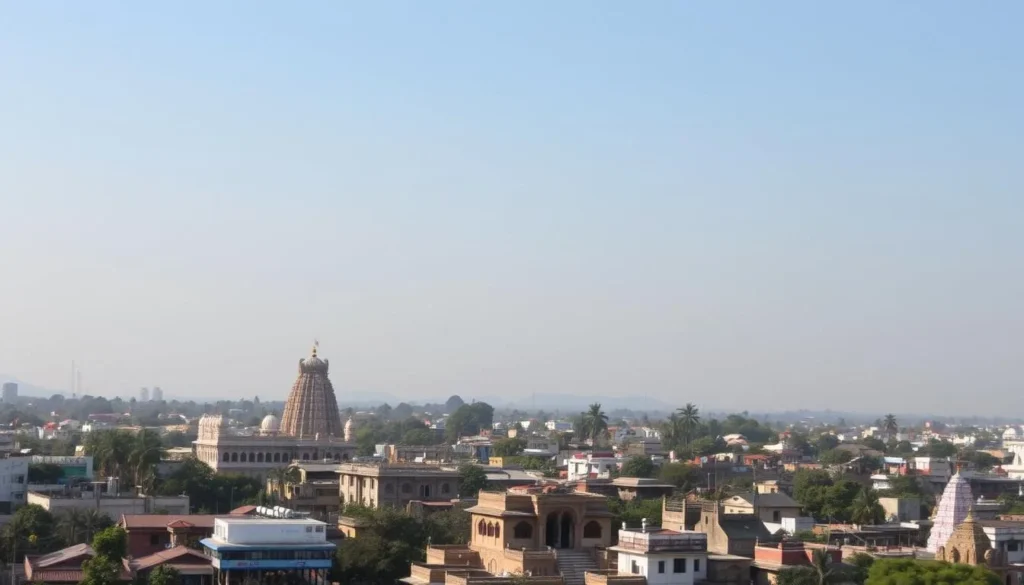
With its rich history and numerous revered temples, Tirupati embodies the spiritual heart of Andhra Pradesh. You will discover why this city is considered the spiritual epicenter, home to some of India’s most revered temples and religious sites.
Understanding Tirupati’s Religious Importance
Tirupati’s religious significance dates back centuries, with the Lord Venkateswara Temple being the crown jewel that attracts millions of devotees annually from across the globe. You will understand the deep spiritual connection people feel to this place, enhancing your appreciation of the temples and rituals you’ll encounter during your visit.
The city’s temples are not just places of worship but also architectural marvels that reflect the rich cultural heritage of Andhra Pradesh. As you explore these sacred sites, you’ll gain insight into the significance of Tirupati in the Hindu faith.
Best Time to Visit Tirupati
The best time to visit Tirupati is between October and February when the weather is pleasant, with temperatures ranging from 15-25°C, making it comfortable to explore the hillside temples. You should avoid the summer months (March to June) when temperatures can soar above 40°C, making temple visits and hill climbs particularly challenging.
If you’re interested in experiencing the vibrant religious festivals, plan your visit during Brahmotsavam (September-October) or Vaikunta Ekadasi (December-January) to witness Tirupati at its most spiritually energetic. The monsoon season (July to September) brings lush greenery to the hills but can sometimes make travel difficult due to heavy rainfall.
Consider that weekends and major holidays see the highest number of visitors, so weekdays might offer a more peaceful experience if you’re flexible with your travel dates.
Sri Venkateswara Temple: The Crown Jewel of Tirupati

Nestled in the hills of Tirupati, the Sri Venkateswara Temple is an architectural marvel and a deeply revered spiritual site. As you visit this temple, you’ll be immersed in a unique spiritual adventure that combines stunning architecture, sacred rituals, and special darshan ceremonies.
History and Architecture of the Temple
The Sri Venkateswara Temple, also known as the Tirumala Temple, boasts a history that spans over 2,000 years. The temple complex has been developed over various periods, including the Chola, Pandya, and Vijayanagara eras, each contributing to its architectural splendor. You’ll marvel at the Dravidian architectural style, featuring a gold-plated dome known as Ananda Nilayam, intricate carvings, and an impressive gopuram or temple tower that stands as a beacon of devotion.
Darshan Experience and Tips
The darshan, or viewing of the deity, is the highlight of any visit to the Sri Venkateswara Temple. You have options ranging from free darshan to special entry tickets that significantly reduce waiting time. It’s essential to prepare for potentially long queues, especially during festivals and weekends, with wait times sometimes extending to several hours or even a full day during peak seasons.
To make the most of your visit, research the temple’s protocols, including dress codes and prohibitions on electronic devices. Traditional attire is preferred, and understanding these requirements will enhance your overall experience.
Temple Rituals and Ceremonies
As you explore the Sri Venkateswara Temple, you’ll witness fascinating daily rituals, including Suprabhatam (morning awakening), Thomala Seva (flower decoration), and Ekantha Seva (night ritual), each carrying deep spiritual significance. Special ceremonies like Brahmotsavam, an annual nine-day festival, showcase the temple’s cultural richness with processions featuring the deity on various vahanas or vehicles.
These rituals and ceremonies are an integral part of the temple’s significance, offering a glimpse into the rich cultural heritage of the region. By participating in or simply observing these events, you’ll gain a deeper understanding of the temple’s importance to devotees.
Tirumala Hills: Beyond the Temple
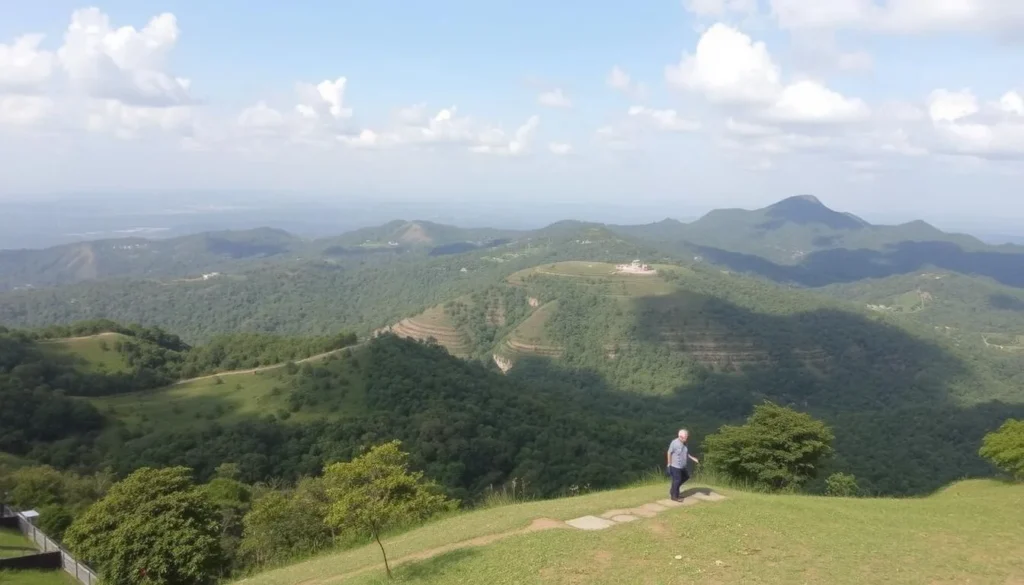
The Tirumala Hills offer more than just a spiritual experience, with breathtaking natural attractions waiting to be explored. As you venture into these hills, you’ll discover a plethora of natural wonders that showcase the region’s geological and ecological significance.
Silathoranam: The Natural Arch
One of the most fascinating attractions in the Tirumala Hills is Silathoranam, a rare natural arch formation and National Geo-Heritage Monument. This natural rock formation is the result of erosion that took place over millions of years, creating an arch that spans eight meters wide and stands three meters tall.
The surrounding greenery creates a peaceful atmosphere, perfect for contemplation and photography. Silathoranam is a testament to the incredible forces of nature that have shaped this region.
Akasa Ganga and Sacred Waterfalls
Another significant attraction is Akasa Ganga, a sacred waterfall with deep mythological connections. According to legend, Lord Vishnu’s divine footprint created this perpetual water source. Many visitors collect the holy water in small containers, as it’s considered highly auspicious and used in various temple rituals.
The serene surroundings and the sound of flowing water make Akasa Ganga a tranquil spot for reflection.
Scenic Viewpoints and Photography Spots
The Tirumala Hills are dotted with spectacular viewpoints that offer panoramic vistas of the surrounding Eastern Ghats and valleys. Sunset Point is particularly popular, providing breathtaking views of the sun setting behind the hills, creating a magical golden glow that photographers find irresistible.
To fully explore these natural attractions, it’s advisable to wear appropriate footwear, as some viewpoints require short hikes on uneven terrain.
Exploring Swami Pushkarini Lake

Located in the heart of the Sri Venkateswara Temple, Swami Pushkarini Lake is a revered site for devotees and visitors alike. This sacred lake is not only a spiritual haven but also a place of great historical and architectural significance.
Spiritual Significance of the Sacred Lake
Swami Pushkarini Lake is believed to be the earthly manifestation of Vaikuntha, the celestial abode of Lord Vishnu, brought to Earth by Garuda. According to legend, Goddess Lakshmi and Lord Vishnu bathed in its waters when they descended to Earth, imbuing the lake with purifying properties. Many devotees consider taking a ritual dip in the Pushkarini Lake an essential part of their pilgrimage, believing it cleanses them of sins before they enter the main temple.
The lake’s significance is further underscored by its architectural beauty. The rectangular lake features stone steps leading down to the water and is surrounded by ancient pillared mandapams (halls) that add to its serene ambiance.
Best Time to Visit and Visitor Information
The best time to visit Swami Pushkarini Lake is early morning, between 5:00 AM and 7:00 AM, when the crowds are thinner and the atmosphere is particularly serene. Visitors are advised that men and women have separate bathing areas, and modest dress is required when not in the water. The lake is accessible throughout the year, but visiting during major festivals like Brahmotsavam offers a chance to see the lake decorated with flowers and lamps.
To make the most of your visit, plan your trip during the cooler months and be prepared for the crowds. The lake’s tranquil environment and spiritual significance make it a must-visit destination for visitors to Tirupati.
Sri Padmavathi Ammavari Temple: The Divine Consort
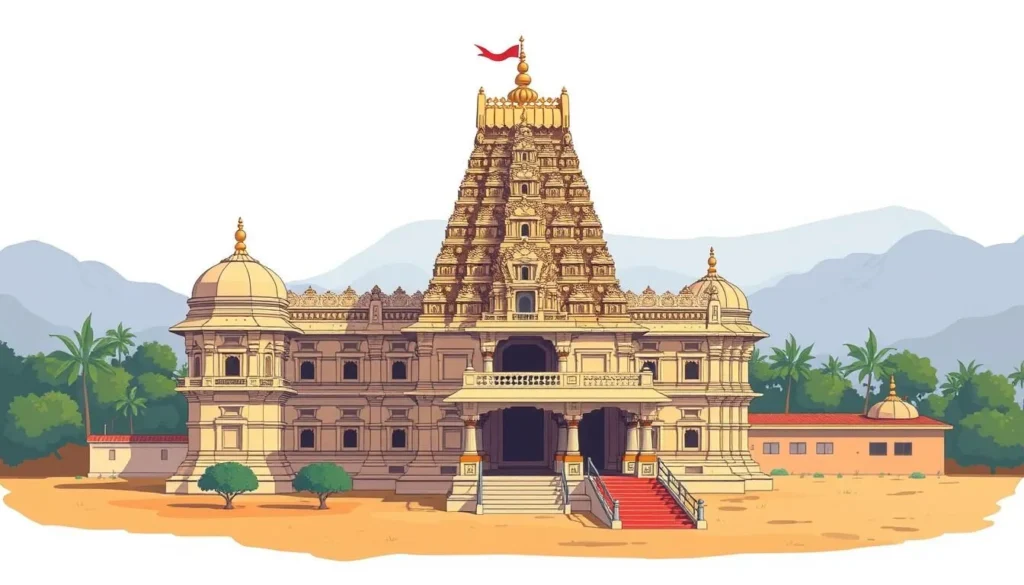
The Sri Padmavathi Ammavari Temple, dedicated to Goddess Padmavathi, is an essential pilgrimage site near Tirupati. Located in Tiruchanoor, this temple is a crucial stop for devotees before they visit the main Tirupati temple. According to tradition, paying respects to Goddess Padmavathi is believed to be a significant part of the Tirupati pilgrimage experience.
Temple History and Architecture
The Sri Padmavathi Ammavari Temple boasts a rich history that dates back several centuries, with significant renovations during the Vijayanagara Empire period. The temple’s Dravidian architectural style is notable for its magnificent gopuram, intricate stone carvings, and spacious courtyard. As you visit this temple, you’ll be impressed by its grandeur and the beautiful craftsmanship that adorns its walls and towers.
The temple’s architecture is not just aesthetically pleasing but also holds deep religious significance. The intricate carvings depict various mythological scenes, adding to the temple’s spiritual ambiance. Visitors can explore the temple’s premises, taking in the serene atmosphere and appreciating the architectural marvels.
Rituals and Festivals
The Sri Padmavathi Ammavari Temple is known for its various rituals and festivals. Devotees can participate in special rituals like Abhishekam (sacred bathing of the deity) and Archana (personalized prayer service), which can be arranged with advance booking. The annual Brahmotsavam festival is a highlight, featuring colorful processions where the goddess is taken around the temple on various vahanas (vehicles).
These rituals and festivals play a significant role in the spiritual lives of devotees, offering a chance to connect with the divine and seek blessings. The vibrant atmosphere during festivals is a treat to experience, with the temple coming alive with music, dance, and devotion.
Visiting Tips and Etiquette
When visiting the Sri Padmavathi Ammavari Temple, it’s essential to dress modestly, with traditional attire preferred. Visitors are required to remove their footwear before entering the temple premises. Maintaining silence in the sanctum sanctorum is a sign of respect, and devotees are encouraged to follow the traditional practices and customs observed at the temple.
The temple is located just 5.3 km from Tirupati, making it easily accessible by local transport. The journey takes approximately 15-20 minutes, allowing for a quick and convenient visit before heading to the main Tirupati temple.
Sri Kapileswara Swamy Temple: Lord Shiva’s Abode
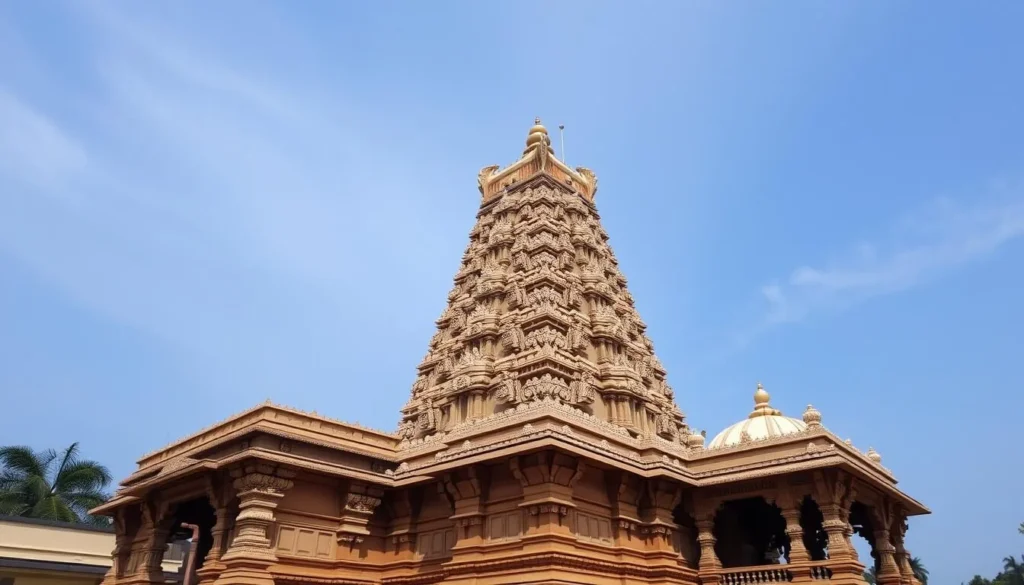
The Sri Kapileswara Swamy Temple, dedicated to Lord Shiva, is a testament to the rich cultural heritage of Tirupati. This ancient temple is not only a significant pilgrimage site but also a marvel of Dravidian architecture.
Architectural Marvel of Dravidian Style
The Sri Kapileswara Swamy Temple showcases exquisite Dravidian architectural elements, with intricately carved pillars and stone sculptures depicting various forms of Lord Shiva. The temple’s gopuram is a magnificent example of Dravidian temple architecture, drawing devotees and architecture enthusiasts alike.
The interior of the temple follows the Chola style of architecture, creating an interesting blend of different South Indian architectural traditions within a single sacred space. This unique blend is a testament to the temple’s historical significance and the various dynasties that have influenced its architecture over the centuries.
Sacred Tank and Temple Premises
A sacred water tank within the temple premises adds to its spiritual significance. The tank is surrounded by open pillared corridors, creating a serene atmosphere for meditation and prayer. Devotees believe that the water in the tank possesses healing properties and the power to cleanse sins.
The temple premises are well-maintained, with spacious courtyards that allow for a peaceful darshan experience even during busy periods. The Sri Kapileswara Swamy Temple is located just 4.4 km from Tirupati’s center, making it easily accessible and an ideal addition to your temple circuit in the region.
Chandragiri Fort and Palace: A Historical Journey
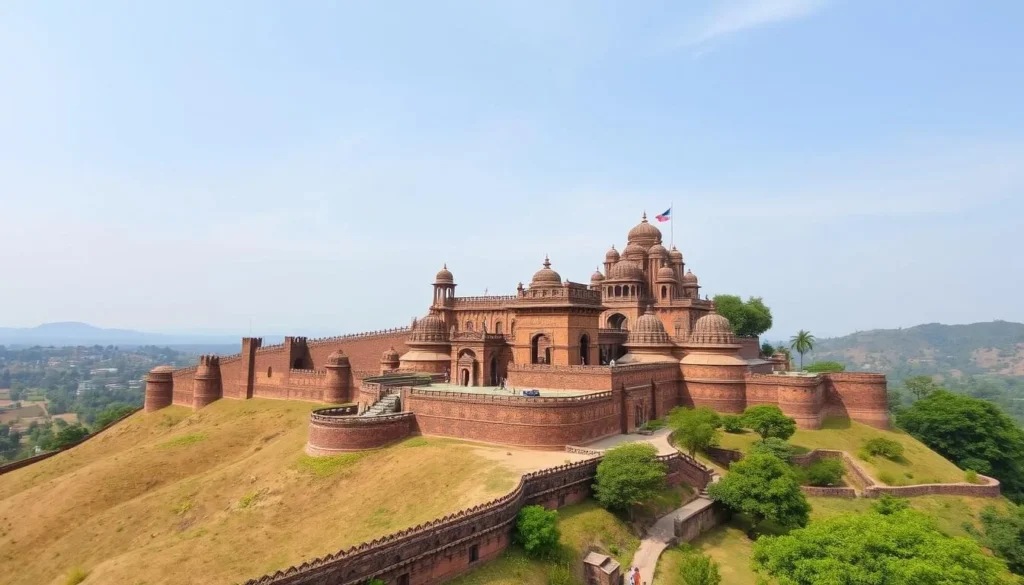
The Chandragiri Fort and Palace, built in the 11th century, is a must-visit historical site that showcases the architectural brilliance of the Vijayanagara Empire. Located just 16 km from Tirupati city center, this magnificent structure still stands today, demonstrating the stunning and divine architecture of Vijayanagara.
Architectural Splendor of Vijayanagara Era
The fort complex showcases the stunning architectural brilliance of the Vijayanagara Empire with its blend of Hindu and Islamic design elements that reflect the cultural fusion of the era. You’ll be amazed by the architectural splendor featuring granite stone construction, intricate carvings, ornate pillars, and strategic defensive structures that have withstood the test of time.
Raja Mahal and Museum Collections
The Raja Mahal (King’s Palace) stands as the centerpiece of the complex, a three-story structure with impressive audience halls, royal quarters, and balconies offering panoramic views of the surrounding landscape. The Archaeological Survey of India museum housed within the palace displays a fascinating collection of artifacts including stone and metal sculptures, coins, manuscripts, and temple models that bring the region’s rich history to life.
Light and Sound Show Experience
The captivating light and sound show, held every fortnight, brings the fort’s history to life through dramatic narration, music, and illumination that recreates significant historical events. Special celebrations like Madras Day feature additional cultural performances and historical reenactments, making it an ideal time to visit if you enjoy festive atmospheres. This experience is a must-have when visiting the Chandragiri Fort and Palace.
As you explore the Chandragiri Fort and Palace, you’ll step back in time and gain insights into the political, cultural, and social aspects of the Vijayanagara period through well-curated exhibits. The fort is among the top tourist places near Tirupati within 50 kms, backed by a rich history. Visiting this historical site is an enriching experience that allows you to connect with the past.
Located near Tirupati city, the Chandragiri Fort and Palace is easily accessible and offers a unique glimpse into the region’s historical significance. Whether you’re a history buff or just looking to explore new places, this fort is a must-visit destination.
Wildlife Encounters at Sri Venkateswara National Park

Sri Venkateswara National Park, named after the revered Lord Venkateswara, is a haven for nature lovers and wildlife enthusiasts. Located just 8 km from Tirupati, this national park offers a refreshing contrast to the spiritual experiences of the temples.
Flora and Fauna Diversity
The park spans approximately 353 square kilometers of the Eastern Ghats, featuring diverse ecosystems including deciduous forests, scrublands, and grasslands. You’ll encounter an impressive biodiversity with over 1,500 plant species, including medicinal herbs, rare orchids, and endemic flora that have adapted to the unique ecological conditions of the Eastern Ghats.
The variety of flora supports a rich array of fauna, making Sri Venkateswara National Park a unique place to observe wildlife in their natural habitat.
Safari Options and Wildlife Spotting
Wildlife enthusiasts will appreciate the chance to spot endangered species like the giant squirrel, four-horned antelope, mouse deer, leopards, monitor lizards, and sloth bears. The park offers various safari options, including jeep safaris and guided nature walks, allowing you to explore different zones of the protected area with knowledgeable guides.
Early morning and late afternoon safaris typically yield the best wildlife sightings, when animals are most active and the lighting is ideal for photography.
Conservation Efforts and Visitor Guidelines
To respect the conservation efforts, you should follow visitor guidelines such as maintaining silence during safaris, not feeding animals, staying on designated paths, and avoiding littering. The park represents an important conservation initiative in the region, working to protect endangered species and their habitats while educating visitors about the importance of biodiversity preservation.
By adhering to these guidelines, you contribute to the conservation of this precious nature reserve, ensuring its beauty and biodiversity are preserved for future generations.
As you explore Sri Venkateswara National Park, you’ll be struck by the distance between this natural haven and the spiritual heart of Tirupati, yet both are integral to the region’s identity. This national park, named after Lord Venkateswara Swamy, is a testament to the region’s rich cultural and natural heritage.
Tirupati, Andhra Pradesh: Best Things to Do – Top Picks
Tirupati, a city in Andhra Pradesh, is a treasure trove of spiritual and natural attractions that cater to diverse interests. As you explore this sacred city, you’ll discover a mix of revered temples, serene landscapes, and family-friendly activities that make it an ideal destination for pilgrims and tourists alike.
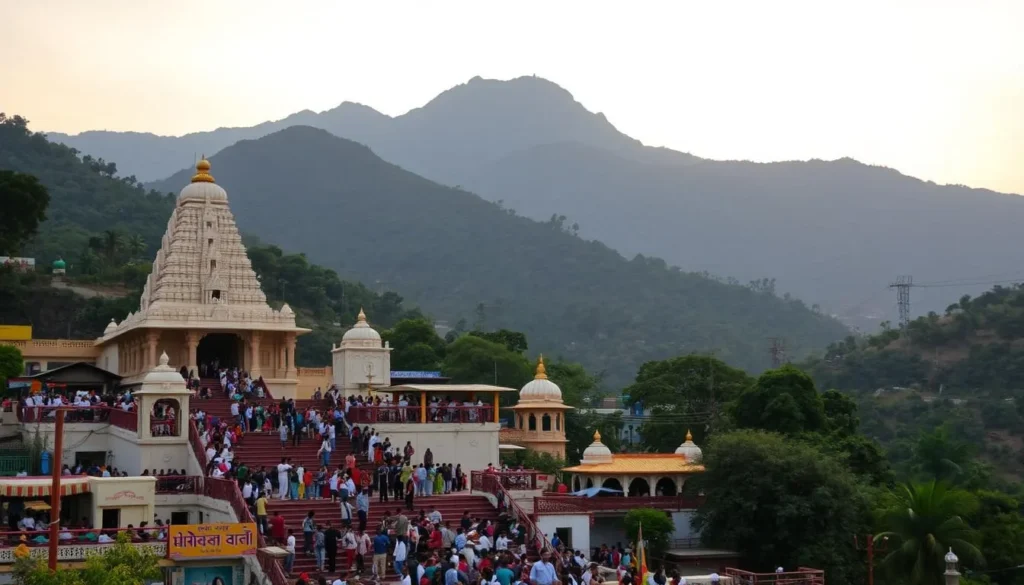
Tirumala Deer Park Reserve: A Family-Friendly Attraction
The Tirumala Deer Park Reserve is a haven for nature lovers and families. Located about 27 km from Tirupati, this park offers a peaceful retreat where you can observe and interact with deer in a semi-natural environment. You can feed the deer with approved food available at the entrance and watch these gentle creatures up close. The park is especially enjoyable for children as it provides both entertainment and education about wildlife conservation in a safe, controlled setting.
As you stroll through the park, you’ll appreciate the serene surroundings and the opportunity to connect with nature. The Tirumala Deer Park Reserve is among the best places to visit near Tirupati within 50 kms, making it a perfect day-trip destination.
Srivari Padalu: The Divine Footprints
Srivari Padalu, situated on Narayanagiri Hill, is a culturally significant site that attracts devotees from across India. It is believed to be the place where Lord Vishnu’s foot first touched the earth, making it a revered pilgrimage site. The site requires a moderate uphill trek, rewarding visitors with not only spiritual significance but also panoramic views of the surrounding landscape and lush forests.
As you visit Srivari Padalu, you’ll be fascinated by the divine footprints of Lord Vishnu, which are considered sacred by believers. The site is an important pilgrimage destination beyond the main Sri Venkateswara Temple, offering a unique spiritual experience.
TTD Gardens: Tranquil Green Spaces
The TTD (Tirumala Tirupati Devasthanams) Gardens are beautifully maintained green spaces that offer a tranquil environment for relaxation and contemplation. As you stroll through the gardens, you’ll be surrounded by colorful flower beds, manicured lawns, and ornamental plants. The gardens feature various themed sections, meditation spaces, and walking paths that provide a peaceful ambiance after visiting the temples.
The careful landscape design incorporates elements of traditional temple garden architecture with modern horticultural practices, creating spaces that are both aesthetically pleasing and spiritually uplifting. The TTD Gardens are an ideal spot to unwind and rejuvenate during your visit to Tirupati.
Cultural Experiences in Tirupati
Immerse yourself in the rich cultural heritage of Tirupati, where every experience is a testament to its vibrant traditions. As you explore this sacred city, you’ll encounter a blend of spiritual and cultural attractions that make your visit truly enriching.
Srivari Museum: Understanding Temple History
Located near the Tirumala Hills, the Srivari Museum is a treasure trove of knowledge about the Sri Venkateswara Temple. As you step inside, you’ll gain fascinating insights into the temple’s rich history and cultural significance. The museum houses an impressive collection of artifacts, including ancient scriptures, religious publications, historical photographs, and temple treasures that document the evolution of worship practices over centuries.
Traditional Arts and Crafts
Tirupati’s vibrant artistic heritage is reflected in its traditional arts and crafts, which have flourished in the region for generations. You’ll discover intricate Kalamkari paintings, wooden toys, and religious icons created by local artisans using techniques passed down through generations. Many workshops and small studios in the city offer demonstrations and hands-on experiences where you can learn about these traditional crafts.
Local Cuisine and Culinary Delights
Your cultural journey wouldn’t be complete without sampling the distinctive local cuisine that reflects the culinary traditions of the region. You’ll enjoy specialties like Tirupati laddu, dosa, vada, and other South Indian vegetarian delicacies served on traditional banana leaves. Many restaurants in the city offer “temple-style” meals that replicate the prasadam served at the temple, providing an authentic culinary experience connected to the spiritual traditions of Tirupati.
As you explore Tirupati, you’ll find that its cultural experiences are deeply intertwined with its spiritual essence, making your visit a memorable and enriching experience.
Natural Wonders Near Tirupati
Tirupati’s environs are dotted with natural wonders that promise an unforgettable experience. As you explore the areas surrounding this spiritually significant city, you’ll discover a diverse range of natural attractions that are sure to captivate your senses.

Talakona Waterfall: The Highest Waterfall in Andhra Pradesh
Talakona Waterfall, located about 50 km from Tirupati within the Sri Venkateswara National Park, is a breathtaking sight. At 270 feet, it’s the highest waterfall in Andhra Pradesh. The name “Talakona” is derived from “tala” meaning “head” and “kona” meaning “hill,” referring to its position at the head of a hill. The waterfall’s pristine waters cascade through dense forest, creating a spectacular natural display.
The surrounding area is rich in medicinal plants and biodiversity, offering a unique rope walk through the canopy that provides a fresh perspective on the forest ecosystem.
Rock Garden: A Sculptural Paradise
The Rock Garden near Tirupati is a fascinating sculptural paradise where natural rock formations are enhanced by artistic interventions. This man-made wonder features creative sculptures, water features, and landscaped gardens that transform natural rock outcroppings into an aesthetic experience.
The garden provides a peaceful retreat with shaded sitting areas where you can relax and appreciate the artistic vision behind this unique attraction.
Hiking and Trekking Opportunities
Adventure enthusiasts will appreciate the numerous hiking and trekking opportunities in the hills surrounding Tirupati. The Seshachalam Hills offer several marked trails that take you through diverse ecosystems, providing opportunities to spot wildlife and enjoy panoramic views of the valley below.
Popular trekking routes include the path to Akasa Ganga, the trail to Papavinasam, and more challenging hikes to various peaks in the Eastern Ghats, rewarding you with spectacular vistas and a sense of accomplishment.
Day Trips from Tirupati
Beyond Tirupati’s sacred sites, the surrounding region beckons with a variety of day trip destinations that promise adventure and serenity. You can enhance your Tirupati experience with rewarding day trips to nearby attractions, each offering a unique perspective on the region’s natural beauty and cultural heritage.
Srikalahasti Temple: The Element Shrine
Srikalahasti Temple, located 39.2 km from Tirupati, is one of the most significant Shaiva temples in South India. The temple’s name is derived from the legend of a spider, snake, and elephant who attained salvation through their devotion to Lord Shiva. The inner sanctum dates back to the 5th century, while the outer structures were added in the 12th century, showcasing the evolution of Dravidian temple architecture.
Horsley Hills: A Refreshing Hill Station
Horsley Hills is a charming hill station situated about 144 km from Tirupati at an elevation of 1,290 meters. Named after W.D. Horsley, a British collector who built a house here in 1870, this hill station features colonial-era buildings, viewpoints offering spectacular vistas, and a microclimate that supports unique flora and fauna. You’ll find relief from the heat and enjoy a refreshing environment.
Kailasakona Waterfalls: Hidden Natural Beauty
Kailasakona Waterfalls, located approximately 75 km from Tirupati, offers a hidden natural paradise with cascading waters surrounded by lush forests and rocky terrain. The journey to these falls takes you through picturesque villages and forest paths, adding to the sense of discovery and adventure. The crystal-clear pool at the base of the falls provides a refreshing spot for a dip.
Spiritual Retreats and Meditation Centers
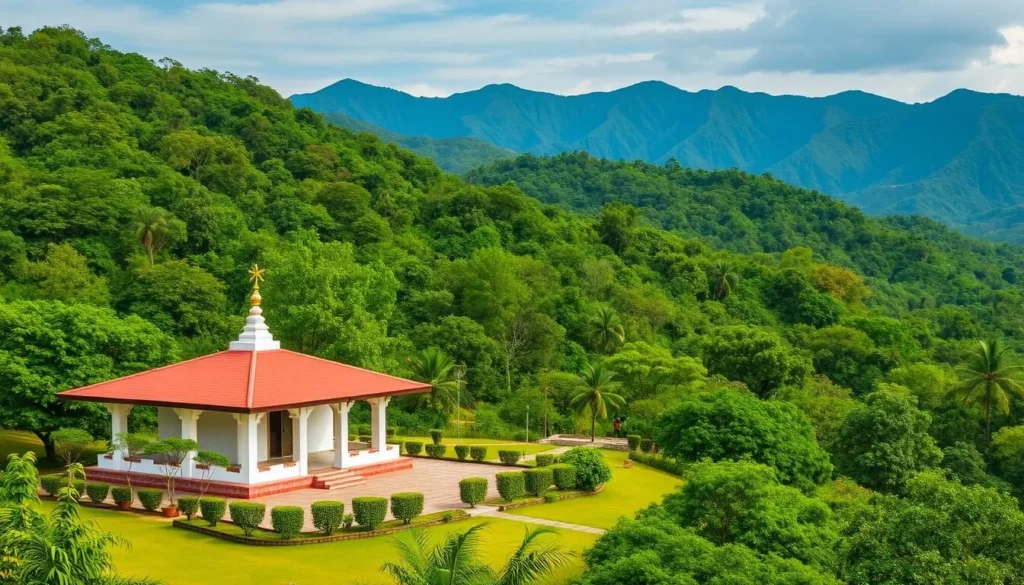
Beyond the revered temples, Tirupati’s serene landscapes host a variety of spiritual retreats and meditation centers that cater to diverse spiritual needs. These centers provide a tranquil atmosphere, allowing you to deepen your spiritual practice and enhance your overall experience in this sacred city.
Yoga and Meditation Facilities
Many centers around Tirupati offer structured yoga programs, ranging from beginner-friendly sessions to advanced practices, often incorporating traditional Hatha and Ashtanga styles with a focus on spiritual development. You can participate in guided meditation sessions led by experienced practitioners who help you connect with the spiritual energy that has drawn pilgrims to this region for centuries.
These facilities typically provide peaceful environments with dedicated meditation halls, often featuring views of the surrounding hills that enhance the contemplative atmosphere. Several centers offer specialized programs combining yoga, meditation, and Ayurvedic treatments for a holistic approach to wellness that addresses physical, mental, and spiritual health.
Ashrams and Spiritual Learning Centers
The ashrams near Tirupati follow various spiritual traditions, with some focusing on Vaishnavite practices aligned with the Lord Venkateswara tradition, while others offer broader Hindu philosophical teachings. You’ll have opportunities to engage in satsangs (spiritual discourses), bhajan sessions (devotional singing), and seva (selfless service) that form the cornerstone of ashram life.
Many temples and spiritual learning centers offer courses on Vedic scriptures, Sanskrit, temple traditions, and Indian philosophy, allowing you to deepen your understanding of the cultural and spiritual context of Tirupati’s temples. These retreats provide a perfect complement to temple visits, allowing you to process and integrate your experience in a supportive environment away from the crowds and activity of the main temple complexes.
By visiting these ashrams and spiritual learning centers, you can enhance your overall experience in Tirupati, making your visit to this sacred place even more meaningful. You’ll find that these centers are located in serene places, providing a peaceful atmosphere that fosters spiritual growth.
Shopping and Souvenirs in Tirupati
Shopping in Tirupati is a delightful experience with numerous options for bringing home meaningful souvenirs that capture the spiritual and cultural essence of your visit.
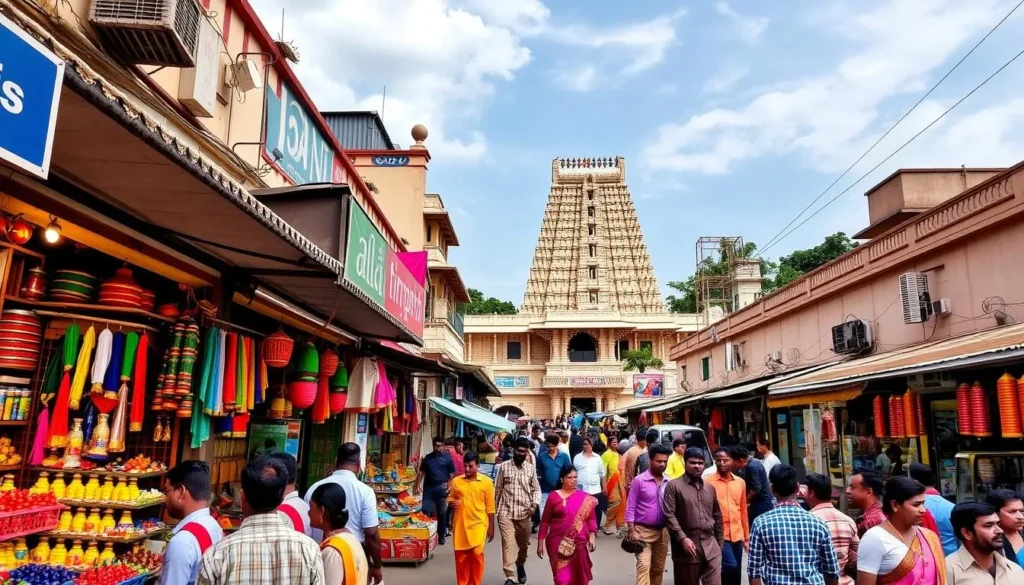
Traditional Handicrafts and Artifacts
Tirupati is renowned for its traditional handicrafts, including intricate wooden carvings of deities, brass and copper items, and Kalamkari paintings that feature mythological themes. These handicrafts are not only decorative but also carry spiritual significance, making them unique souvenirs.
Temple Souvenirs and Religious Items
The areas surrounding the temple offer a wide selection of religious items, including deity statues in various materials, prayer beads, incense, and devotional music. You can also purchase prasadam, with the famous Tirupati laddu being a sought-after item that devotees take home as a blessed souvenir.
Local Markets and Shopping Areas
Tirupati’s main shopping areas include the Tirumala Shopping Complex near the temple, where you’ll find authorized vendors selling authentic temple-related items. In the city center, areas like Gandhi Road and Prakasam Road feature numerous shops selling everything from traditional handicrafts to modern clothing.
Practical Travel Information for Tirupati Visitors
Before you visit Tirupati, understanding the practical aspects of your trip can make a significant difference. Tirupati, being a major pilgrimage site, attracts a large number of visitors, and being prepared can enhance your experience.

Accommodation Options for All Budgets
Tirupati offers a wide range of accommodation options to suit various budgets and preferences. You can choose from luxury hotels to affordable guesthouses. The Tirumala Tirupati Devasthanams (TTD) operates several guest houses on Tirumala Hill near the main temple, which are very popular among pilgrims. However, these require advance booking through their official website.
In Tirupati city, you’ll find numerous private hotels ranging from budget to luxury, with many concentrated around the railway station and bus stand for convenient access to transportation. This variety ensures that you can find a suitable place to stay, whether you’re looking for luxury or affordability.
Transportation Within and Around Tirupati
Getting around Tirupati is relatively straightforward with several transportation options available. The APSRTC buses connect Tirupati city with Tirumala Hills and other attractions in the area. Prepaid taxis and auto-rickshaws are readily available at the railway stations and bus stands, offering convenient door-to-door service.
For traveling to Tirumala from Tirupati, you can take the bus or hire a taxi, with the journey taking approximately 30-45 minutes depending on traffic conditions. There are four railway stations in Tirupati: Tirupati (TPTY), Renigunta Junction (RU), Tirumlai Hls Oa (TTH), and Tirupati West Halt (TPW), making it easily accessible by train.
Travel Tips and Local Customs
When visiting temples in Tirupati, it’s essential to dress modestly. Men typically wear dhotis or pants (no shorts) and shirts, while women wear sarees, salwar kameez, or modest western attire covering shoulders and knees. Be aware that Tirumala follows strict vegetarian principles, with no meat, eggs, or alcohol permitted in the sacred area, so plan your dining accordingly.
The best time to visit for darshan at the main temple is early morning (3:00 AM to 6:00 AM) or late evening after 7:00 PM when crowds are typically smaller. Consider purchasing special darshan tickets in advance if your time is limited, as regular lines can involve waiting for several hours, especially during weekends and festival periods.
By being informed about these practical aspects, you can have a more enjoyable and stress-free trip to Tirupati, allowing you to focus on the spiritual and cultural activities that this city has to offer.
Conclusion
As you reflect on your time in Tirupati, you’ll realize that this multifaceted destination has catered to your every interest, whether spiritual, cultural, or adventurous. You’ve now discovered the incredible diversity of experiences that Tirupati, Andhra Pradesh, offers, from its world-renowned temples to its natural wonders and cultural attractions.
The spiritual journey through Sri Venkateswara Temple and other sacred sites provides a profound connection to India’s religious traditions that has drawn pilgrims for centuries. Beyond the temples, you’ve seen how Tirupati’s natural landscape offers breathtaking scenery, wildlife encounters, and outdoor activities that appeal to nature enthusiasts and adventure seekers alike.
The rich cultural experiences available through museums, craft centers, and local cuisine give you a deeper appreciation of the region’s heritage and traditions. Day trips to nearby attractions like Srikalahasti Temple and Horsley Hills expand your understanding of the region and provide diverse experiences that complement your time in Tirupati.
Whether you’re a spiritual seeker, history buff, nature lover, or cultural explorer, Tirupati truly offers something special for every type of traveler. Planning your trip with consideration for the best time to visit, accommodation options, and local customs will help ensure a smooth and rewarding experience in this multifaceted destination. The memories and experiences you gather in Tirupati will likely stay with you long after your journey ends, perhaps calling you back to explore more of what this remarkable place has to offer.
As one of India’s most significant spiritual destinations that successfully balances religious importance with tourist-friendly infrastructure, Tirupati stands as a model for how sacred sites can welcome visitors from around the world while maintaining their spiritual integrity. Your journey through Tirupati represents not just a trip to a destination, but an opportunity for personal growth, cultural understanding, and spiritual reflection in one of India’s most beloved pilgrimage centers.
—
The above is subject to change.
Check back often to TRAVEL.COM for the latest travel tips and deals.
